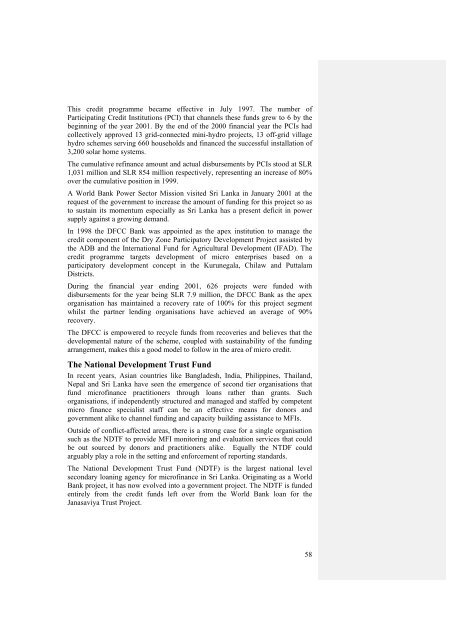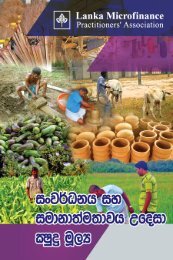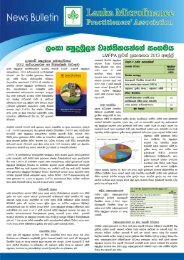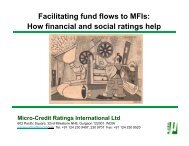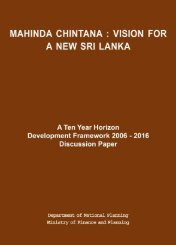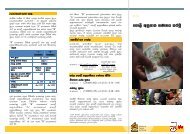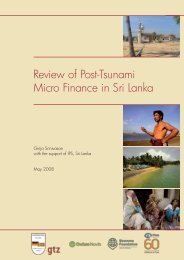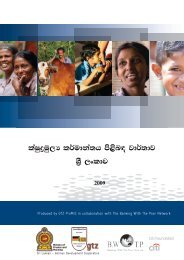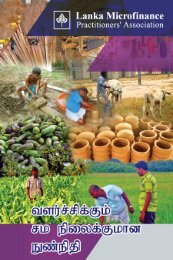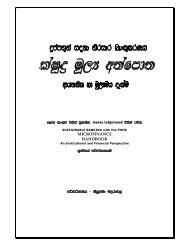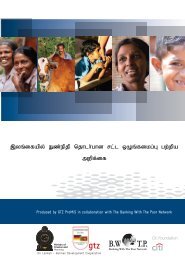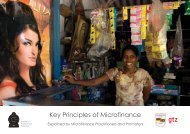National Microfinance Study of Sri Lanka: Survey of Practices and ...
National Microfinance Study of Sri Lanka: Survey of Practices and ...
National Microfinance Study of Sri Lanka: Survey of Practices and ...
Create successful ePaper yourself
Turn your PDF publications into a flip-book with our unique Google optimized e-Paper software.
This credit programme became effective in July 1997. The number <strong>of</strong><br />
Participating Credit Institutions (PCI) that channels these funds grew to 6 by the<br />
beginning <strong>of</strong> the year 2001. By the end <strong>of</strong> the 2000 financial year the PCIs had<br />
collectively approved 13 grid-connected mini-hydro projects, 13 <strong>of</strong>f-grid village<br />
hydro schemes serving 660 households <strong>and</strong> financed the successful installation <strong>of</strong><br />
3,200 solar home systems.<br />
The cumulative refinance amount <strong>and</strong> actual disbursements by PCIs stood at SLR<br />
1,031 million <strong>and</strong> SLR 854 million respectively, representing an increase <strong>of</strong> 80%<br />
over the cumulative position in 1999.<br />
A World Bank Power Sector Mission visited <strong>Sri</strong> <strong>Lanka</strong> in January 2001 at the<br />
request <strong>of</strong> the government to increase the amount <strong>of</strong> funding for this project so as<br />
to sustain its momentum especially as <strong>Sri</strong> <strong>Lanka</strong> has a present deficit in power<br />
supply against a growing dem<strong>and</strong>.<br />
In 1998 the DFCC Bank was appointed as the apex institution to manage the<br />
credit component <strong>of</strong> the Dry Zone Participatory Development Project assisted by<br />
the ADB <strong>and</strong> the International Fund for Agricultural Development (IFAD). The<br />
credit programme targets development <strong>of</strong> micro enterprises based on a<br />
participatory development concept in the Kurunegala, Chilaw <strong>and</strong> Puttalam<br />
Districts.<br />
During the financial year ending 2001, 626 projects were funded with<br />
disbursements for the year being SLR 7.9 million, the DFCC Bank as the apex<br />
organisation has maintained a recovery rate <strong>of</strong> 100% for this project segment<br />
whilst the partner lending organisations have achieved an average <strong>of</strong> 90%<br />
recovery.<br />
The DFCC is empowered to recycle funds from recoveries <strong>and</strong> believes that the<br />
developmental nature <strong>of</strong> the scheme, coupled with sustainability <strong>of</strong> the funding<br />
arrangement, makes this a good model to follow in the area <strong>of</strong> micro credit.<br />
The <strong>National</strong> Development Trust Fund<br />
In recent years, Asian countries like Bangladesh, India, Philippines, Thail<strong>and</strong>,<br />
Nepal <strong>and</strong> <strong>Sri</strong> <strong>Lanka</strong> have seen the emergence <strong>of</strong> second tier organisations that<br />
fund micr<strong>of</strong>inance practitioners through loans rather than grants. Such<br />
organisations, if independently structured <strong>and</strong> managed <strong>and</strong> staffed by competent<br />
micro finance specialist staff can be an effective means for donors <strong>and</strong><br />
government alike to channel funding <strong>and</strong> capacity building assistance to MFIs.<br />
Outside <strong>of</strong> conflict-affected areas, there is a strong case for a single organisation<br />
such as the NDTF to provide MFI monitoring <strong>and</strong> evaluation services that could<br />
be out sourced by donors <strong>and</strong> practitioners alike. Equally the NTDF could<br />
arguably play a role in the setting <strong>and</strong> enforcement <strong>of</strong> reporting st<strong>and</strong>ards.<br />
The <strong>National</strong> Development Trust Fund (NDTF) is the largest national level<br />
secondary loaning agency for micr<strong>of</strong>inance in <strong>Sri</strong> <strong>Lanka</strong>. Originating as a World<br />
Bank project, it has now evolved into a government project. The NDTF is funded<br />
entirely from the credit funds left over from the World Bank loan for the<br />
Janasaviya Trust Project.<br />
58


